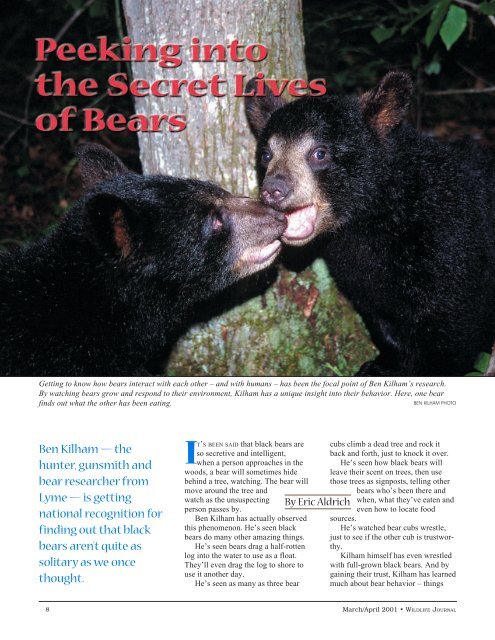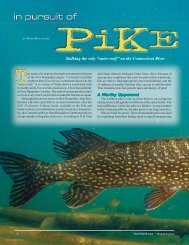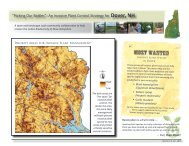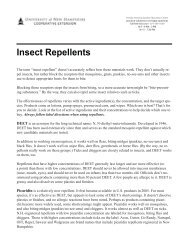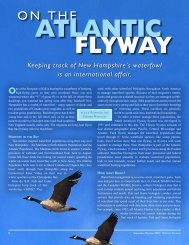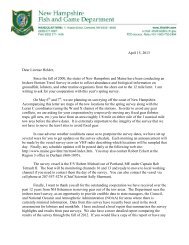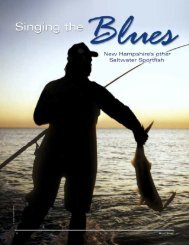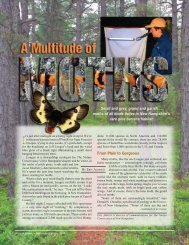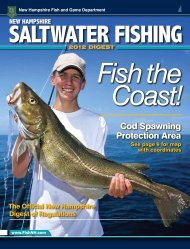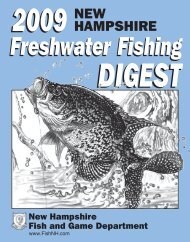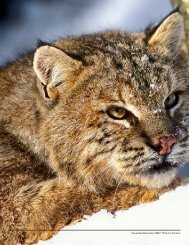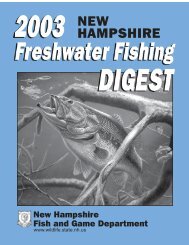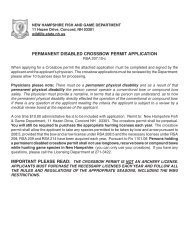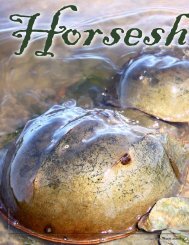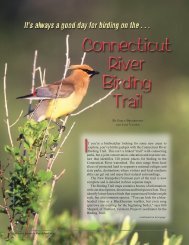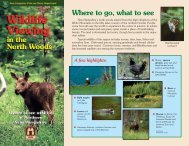Ben Kilham - New Hampshire Fish and Game Department
Ben Kilham - New Hampshire Fish and Game Department
Ben Kilham - New Hampshire Fish and Game Department
Create successful ePaper yourself
Turn your PDF publications into a flip-book with our unique Google optimized e-Paper software.
Getting to know how bears interact with each other – <strong>and</strong> with humans – has been the focal point of <strong>Ben</strong> <strong>Kilham</strong>’s research.<br />
By watching bears grow <strong>and</strong> respond to their environment, <strong>Kilham</strong> has a unique insight into their behavior. Here, one bear<br />
finds out what the other has been eating.<br />
BEN KILHAM PHOTO<br />
<strong>Ben</strong> <strong>Kilham</strong> — the<br />
hunter, gunsmith <strong>and</strong><br />
bear researcher from<br />
Lyme — is getting<br />
national recognition for<br />
finding out that black<br />
bears aren’t quite as<br />
solitary as we once<br />
thought.<br />
IT’S BEEN SAID that black bears are<br />
so secretive <strong>and</strong> intelligent,<br />
when a person approaches in the<br />
woods, a bear will sometimes hide<br />
behind a tree, watching. The bear will<br />
move around the tree <strong>and</strong><br />
watch as the unsuspecting<br />
person passes by.<br />
<strong>Ben</strong> <strong>Kilham</strong> has actually observed<br />
this phenomenon. He’s seen black<br />
bears do many other amazing things.<br />
He’s seen bears drag a half-rotten<br />
log into the water to use as a float.<br />
They’ll even drag the log to shore to<br />
use it another day.<br />
He’s seen as many as three bear<br />
By Eric Aldrich<br />
cubs climb a dead tree <strong>and</strong> rock it<br />
back <strong>and</strong> forth, just to knock it over.<br />
He’s seen how black bears will<br />
leave their scent on trees, then use<br />
those trees as signposts, telling other<br />
bears who’s been there <strong>and</strong><br />
when, what they’ve eaten <strong>and</strong><br />
even how to locate food<br />
sources.<br />
He’s watched bear cubs wrestle,<br />
just to see if the other cub is trustworthy.<br />
<strong>Kilham</strong> himself has even wrestled<br />
with full-grown black bears. And by<br />
gaining their trust, <strong>Kilham</strong> has learned<br />
much about bear behavior – things<br />
8 March/April 2001 • WILDLIFE JOURNAL
that no one has known before.<br />
<strong>Kilham</strong>’s insight into bear behavior<br />
isn’t just interesting trivia. It’ll<br />
help people reduce their conflicts with<br />
this intelligent <strong>and</strong> amazing animal.<br />
“As we learn more about bear<br />
behavior, we better underst<strong>and</strong> these<br />
bear/human conflicts,” <strong>Kilham</strong> said.<br />
“We begin to learn that it’s not a<br />
nuisance bear at all. It’s the way<br />
people are leaving food around <strong>and</strong><br />
interacting with bears.”<br />
Animal Household<br />
You’ve probably already heard of<br />
<strong>Ben</strong> <strong>Kilham</strong>. The Lyme resident has<br />
been featured in two National<br />
Geographic TV specials, NBC<br />
Dateline, CBS Coast to Coast, <strong>New</strong><br />
<strong>Hampshire</strong> Crossroads, Field <strong>and</strong><br />
Stream magazine, the Boston Globe<br />
<strong>and</strong> many others.<br />
The attention comes from<br />
<strong>Kilham</strong>’s experiences over the past<br />
few years raising <strong>and</strong> releasing two<br />
dozen cubs or yearlings that were<br />
orphaned or starving. He raises the<br />
bears, releases them back to the wild<br />
(sometimes with radio-telemetry<br />
collars) <strong>and</strong> in the process learns as<br />
much about their behavior as he can.<br />
<strong>Kilham</strong> is specially licensed by the<br />
<strong>New</strong> <strong>Hampshire</strong> <strong>Fish</strong> <strong>and</strong> <strong>Game</strong><br />
<strong>Department</strong> to do this research.<br />
His project, going on nine years<br />
now, evolved from the <strong>Kilham</strong><br />
family’s habit of taking all sorts of<br />
injured <strong>and</strong> orphaned wildlife into<br />
their 1812 Federal-style house in<br />
Lyme village. The critters included<br />
ravens, crows, foxes, woodchucks,<br />
beavers, porcupines, raccoons; you<br />
name it...but no bears.<br />
<strong>Kilham</strong>’s father, Lawrence<br />
<strong>Kilham</strong>, had a permit to raise these<br />
animals – <strong>and</strong> he learned a lot from<br />
them. The elder <strong>Kilham</strong>, who died last<br />
September, was a prominent microbiologist<br />
at Dartmouth Medical School<br />
<strong>and</strong> an accomplished ornithologist<br />
who authored many articles <strong>and</strong> books<br />
on birds <strong>and</strong> nature.<br />
<strong>Kilham</strong>, who st<strong>and</strong>s 6 feet, 5 inches <strong>and</strong> weighs 250 pounds, somewhat assumes<br />
the role of a bear himself as he raises orphaned cubs or starving yearlings. By<br />
roughhousing with bears, <strong>Kilham</strong> gains their trust <strong>and</strong> respect.<br />
JEROME ROBINSON PHOTO<br />
Hunter <strong>and</strong> Gunsmith<br />
After attending the University of<br />
<strong>New</strong> <strong>Hampshire</strong> <strong>and</strong> earning a degree<br />
in wildlife management (despite the<br />
challenges of dyslexia), <strong>Ben</strong> <strong>Kilham</strong><br />
worked as a gunsmith throughout the<br />
Northeast for several major firearms<br />
manufacturers. He has a U.S. patent<br />
for a safety mechanism for a pistol<br />
<strong>and</strong> has established a reputation as a<br />
specialist in pistols <strong>and</strong> restoring<br />
antique guns.<br />
<strong>Kilham</strong> eventually returned to the<br />
family home in the Connecticut River<br />
Valley town of Lyme, where he<br />
continues his gunsmith business <strong>and</strong><br />
enjoys hunting deer <strong>and</strong> upl<strong>and</strong> game<br />
birds.<br />
(Incidentally, <strong>Kilham</strong>’s gunsmith<br />
business <strong>and</strong> passion for hunting is<br />
often left out of the articles <strong>and</strong> TV<br />
features about him. In fact, one<br />
publisher rejected <strong>Kilham</strong>’s own book<br />
idea, saying the public wouldn’t be<br />
able to reconcile his hunting <strong>and</strong><br />
gunsmith business with his bear<br />
research.)<br />
<strong>Kilham</strong> never shook his<br />
household’s interest in taking in<br />
wayward wildlife...<strong>and</strong> studying the<br />
creatures’ habits.<br />
“I was interested in the same type<br />
of research that my father had done,<br />
but I was more interested in carnivores,<br />
like coyotes <strong>and</strong> fishers,”<br />
<strong>Kilham</strong> said. “I wanted to follow them<br />
through their whole life cycle.<br />
Researchers tend to work with just<br />
adult animals.”<br />
In 1992, <strong>Kilham</strong> ended up with two<br />
emaciated bear cubs – only 4 pounds<br />
in mid-April. He wanted to raise <strong>and</strong><br />
observe them, then release them back<br />
to the wild.<br />
“I told Dr. Norm<strong>and</strong>eau (<strong>Fish</strong> <strong>and</strong><br />
<strong>Game</strong>’s executive director at the time)<br />
that I was going to make them<br />
independent animals, rather than<br />
dependent on humans, <strong>and</strong> that I<br />
would document the whole process,”<br />
<strong>Kilham</strong> said.<br />
By the time the cubs were eight<br />
months old, <strong>Kilham</strong> invited Eric Orff<br />
(<strong>Fish</strong> <strong>and</strong> <strong>Game</strong> wildlife biologist) to<br />
see the progress.<br />
“I got to observe up close <strong>and</strong><br />
continued on next page<br />
WILDLIFE JOURNAL • March/April 2001 9
Black bears will eat a wide variety of foods. <strong>Kilham</strong> has<br />
documented over 125 different plant <strong>and</strong> animal species<br />
that bears will eat. During the spring, bears seek sedges,<br />
buds <strong>and</strong> other early plants.<br />
It’s more than play time. These cubs are practicing what<br />
<strong>Kilham</strong> calls “ritualistic wrestling,” in which two bears that<br />
encounter each other wrestle a little bit, on two feet, to<br />
determine whether they can trust the other.<br />
continued from previous page<br />
personal how a bear sees with its<br />
nose,” Orff recalled. “I learned more<br />
in those four or five hours than I had<br />
learned in my many years of working<br />
with bears.”<br />
“Mother Bear Man”<br />
Since then, <strong>Kilham</strong> has raised <strong>and</strong><br />
released 24 cubs or yearlings, most of<br />
which came from <strong>New</strong> <strong>Hampshire</strong>.<br />
<strong>Kilham</strong> starts raising the cubs in<br />
his house, feeding them various forms<br />
of synthetic milk through a bottle four<br />
times a day. When the weather warms<br />
up, <strong>and</strong> by the time the cubs are about<br />
four months old, <strong>Kilham</strong> takes the<br />
bears to a nearby fenced-in area in the<br />
woods. He has rigged a door so that<br />
the bears can come <strong>and</strong> go from the<br />
fenced area as they choose.<br />
<strong>Kilham</strong> visits the bears here every<br />
day, sometimes spending many hours<br />
with them. He walks them daily,<br />
taking them to all sorts of places<br />
within walking distance – sometimes<br />
just for the exercise <strong>and</strong> sometimes<br />
for research. For instance, <strong>Kilham</strong><br />
may take a bear to trees marked by<br />
other bears to see how it’ll react; or<br />
he’ll take a bear to a feeding area rich<br />
with acorns.<br />
“These are not cage-raised bears,”<br />
<strong>Kilham</strong> said. “They’re not dependent.<br />
And in this way they become very<br />
well educated about how to get along.<br />
So, by the time they’re 18-monthsold,<br />
there’s nothing they want better<br />
than another bear as a mate.”<br />
When they’re that age, the bears<br />
are usually ready to start fattening up<br />
for the winter <strong>and</strong> disperse on their<br />
own. <strong>Kilham</strong> tries to release them<br />
where they’re ranges won’t overlap,<br />
though some overlap is unavoidable.<br />
“Dispersal is a tough struggle for<br />
bears, especially for young males,<br />
because they have such a huge<br />
range,” <strong>Kilham</strong> said. “They’ll travel 5<br />
to 200 miles away. Females are more<br />
likely to stay put in a much smaller<br />
home range.”<br />
<strong>Kilham</strong> releases some of the bears<br />
with radio collars so he can find them<br />
<strong>and</strong> follow their progress. Others have<br />
ear tags, <strong>and</strong> some (such as yearlings<br />
recovering from starvation) go with<br />
nothing – “bear” naked, if you will.<br />
Privileged Position<br />
<strong>Kilham</strong> can visit the collared bears<br />
anytime he wants. There’s one fiveyear-old<br />
female, for instance, that he<br />
visits often for research. As <strong>Kilham</strong><br />
approaches the bear, he’ll make a few<br />
vocalizations so she recognizes him.<br />
Then they’ll exchange greetings <strong>and</strong><br />
<strong>Kilham</strong> will see what she’s doing.<br />
This privilege has allowed <strong>Kilham</strong><br />
to observe many little-known aspects<br />
of black bear behavior. He’s been<br />
able to watch bears during all times of<br />
the year as they play, forage, prepare<br />
for denning <strong>and</strong> communicate with<br />
other bears in various ways.<br />
By wrapping a cloth measuring tape<br />
around a bear’s waist, <strong>Kilham</strong> has<br />
followed a bear’s weight gain in the<br />
summer <strong>and</strong> fall, then while she’s in<br />
the den during winter, <strong>and</strong> again when<br />
she emerges from the den in the spring.<br />
“What’s remarkable is the weight<br />
gain in the fall, about 100 pounds a<br />
month,” he said. “That mast crop is so<br />
important because it has to help the<br />
bears get through the winter, spring<br />
<strong>and</strong> until the next mast crop comes in.”<br />
Using his gunsmithing tools <strong>and</strong><br />
skills, <strong>Kilham</strong> has gotten good at<br />
rigging up remote cameras. The<br />
cameras catch which bears are in the<br />
area <strong>and</strong> what they’re doing, such as<br />
foraging, marking trees <strong>and</strong> even<br />
napping.<br />
<strong>Kilham</strong> has strapped his remote<br />
camera to a tree where bears were<br />
frequently feeding nearby. He aimed<br />
the camera at another tree that had<br />
10 March/April 2001 • WILDLIFE JOURNAL
For the most part, a black bear “sees” with its nose. After<br />
sniffing out this red pine, this bear is leaving footprints,<br />
warning other bears that this turf is taken.<br />
<strong>Kilham</strong> releases some bears with radio-telemetry collars.<br />
Signals sent from the collars help him find bears any time of<br />
the year <strong>and</strong> greatly assist his research.<br />
BEN KILHAM PHOTOS<br />
been marked by bears, <strong>and</strong> over a 24-<br />
hour period, found that the tree was a<br />
virtual neon sign for bears, advertising<br />
the nearby feeding place.<br />
He found that as many as six bears<br />
were visiting the tree during that time,<br />
checking out who had been there,<br />
what they had been eating <strong>and</strong> when<br />
they were there (because the odor<br />
dissipates over time).<br />
The People’s Bears<br />
“He has learned a lot of things<br />
about the behavior of black bears that<br />
you won’t find in the literature,” said<br />
Kip Adams, <strong>Fish</strong> <strong>and</strong> <strong>Game</strong>’s bear<br />
project leader. “And the more we<br />
know about their behavior, the better<br />
we can manage them.”<br />
<strong>Kilham</strong>’s finding that bears will<br />
communicate information about food<br />
sources has many implications. For<br />
one thing, it shows that trapping <strong>and</strong><br />
relocating trouble bears is sometimes<br />
ineffective. The trapped bear may still<br />
get into trouble elsewhere, <strong>and</strong><br />
meanwhile, other bears may continue<br />
visiting the original site if there’s still<br />
food available. Ultimately, <strong>Kilham</strong>’s<br />
finding underscores the importance of<br />
keeping human food away from black<br />
bears, Adams said.<br />
At the outset of <strong>Kilham</strong>’s project,<br />
<strong>Fish</strong> <strong>and</strong> <strong>Game</strong> <strong>Department</strong> officials<br />
had concerns that the bears may<br />
become habituated to humans <strong>and</strong><br />
may essentially lose their wildness.<br />
But so far, they’ve been satisfied.<br />
“These bears are a public resource<br />
– they belong to the people of <strong>New</strong><br />
<strong>Hampshire</strong> likely to cause – <strong>and</strong> trouble they should with be<br />
wild,” Adams said. “From what we’ve<br />
seen so far, the bears he’s released<br />
seem pretty wild. If I try to approach<br />
one in the woods without <strong>Ben</strong> being<br />
present, that bear would be gone. It<br />
wouldn’t let me get near.”<br />
And so far, the bears <strong>Kilham</strong> has<br />
released haven’t seemed any less or<br />
more<br />
humans than ordinary bears, Adams<br />
said.<br />
Another benefit is that <strong>Kilham</strong> has<br />
focused a lot of attention on black<br />
bears, their behavior <strong>and</strong> on ways that<br />
people can avoid conflicts with them.<br />
Aside from the media attention on<br />
<strong>Kilham</strong>’s work, he has spoken to<br />
many groups around the state,<br />
showing them slides, answering<br />
questions <strong>and</strong> debunking myths about<br />
bears.<br />
“One of the major things I’m able<br />
to say during these talks is that black<br />
bears are not as solitary as we thought<br />
they were,” <strong>Kilham</strong> said. “They’re<br />
very much social <strong>and</strong> cooperative<br />
animals.”<br />
As for the future, <strong>Kilham</strong> hopes<br />
his work will benefit endangered bear<br />
species, such as giant p<strong>and</strong>as. His<br />
findings <strong>and</strong> techniques for studying<br />
black bears may help refine research<br />
on the world’s rare bears.<br />
Meanwhile, <strong>Kilham</strong> plans to<br />
continue the research <strong>and</strong> keep<br />
looking for higher levels of cooperation<br />
among bears.<br />
“I’ll keep going,” he said. “There<br />
are still a lot of unanswered questions.”<br />
■<br />
“They’re very much social <strong>and</strong><br />
cooperative animals.”<br />
SUSAN SAUER PHOTO/NETWORK PUBLICATIONS<br />
WILDLIFE JOURNAL • March/April 2001 11


